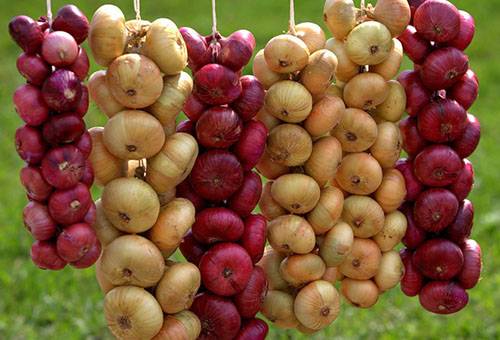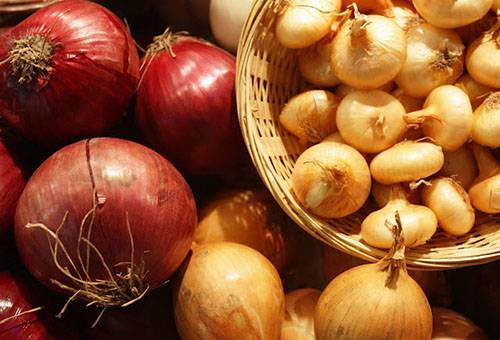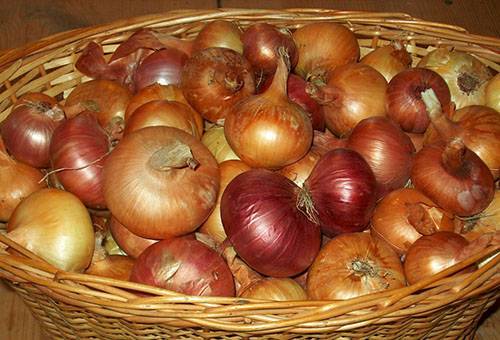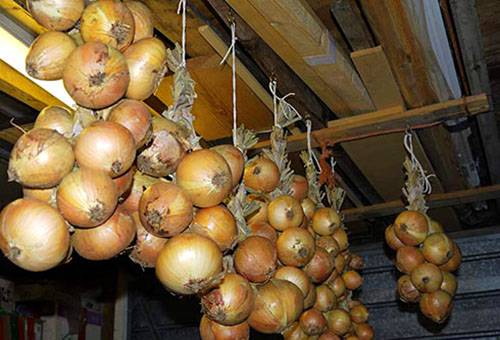How and where to store onions in winter?
Content:
Every summer resident and gardener knows that to grow and harvest a good harvest of onions is half the battle. So that he lay until spring and remained just as useful, you need to know how to store onions, what conditions are best for him, and which, on the contrary, can lead to spoilage.
Start by preparing
First of all, the product must be thoroughly dried. This will provide longer storage of onions and protect it from rot. Better and faster onions dry in natural conditions at a temperature of 25-30 ° C. In sunny weather, the crop is laid out in a single layer in the open air. Some simply leave it for a couple of weeks right in the garden and periodically turn the bulbs over.
If the weather does not allow the onion to dry as described above, place it in a well-ventilated place where it does not become damp. You can put it in the yard under a canopy, in the gazebo or on the balcony. Vegetables dry pretty quickly in shell nets. They pass air on each side, so you do not have to constantly mix the bulbs. Also, the bulbs can be tied in small bundles and hang on the street or indoors in a draft.
After drying, onions need to be cut on each side. Trim the roots, and also cut the feathers, leaving a small neck about 5 cm in size. Before you save the onions for the winter, carefully sort them, otherwise you risk losing the whole batch due to a pair of spoiled bulbs. Healthy bulbs of large or medium size are suitable for long-term storage. They should not be visible damage and signs of rot. Small, unripe and, on the contrary, overripe bulbs will not lie for a long time, therefore it is better to use them first of all.
It is recommended to distribute the onions separately by grades, because they can vary by shelf life.
- Sharp varieties (Rostov, Krasnoyarsk, Arzamassky) are best stored.
- The peninsula onion (Golden Ball, Danilovsky) lies slightly worse.
- Sweet varieties (Yalta, Spanish) are characterized by a minimum shelf life.
Optimum conditions: at what temperature and humidity to store onions?
- When stored in basements, it is recommended to maintain a temperature in the range from 0 to 3 ° C and humidity not higher than 70-85%.
- It is recommended to store onions in the apartment at temperatures up to 18-22 ° С and humidity around 50-70%.
- Leek will retain its freshness at a temperature of -1 to +2 ° C and a humidity of 80-85%.
Failure to comply with these conditions (for example, too humid and warm rooms) can lead to decay, sprouting, and the development of diseases. True, a slight decrease in temperature is allowed.
Where to store onions?
An ideal place to store onions in the cold season is a dry cellar or cellar. The main thing is that the temperature in the room does not fall much below zero. If the conditions in the attic are optimal, then you can store them there.
Tip
It is not recommended to store food in the garage. Car exhaust fumes will not affect their taste and beneficial properties in the best way.
Not everyone, especially in urban conditions, has the opportunity to store crops in the cellar. The best solution in this case is to store onions at home. It is recommended to highlight a dark and cool place where the sun does not fall. It can be a corridor, closet or pantry. In addition to space, the container also affects the shelf life, so its choice should be taken no less responsibly. Consider the most affordable and common options.
- Plastic or wooden boxes with ventilated holes, thanks to which the bow is well ventilated. It is good if the height of the boxes does not exceed 30-35 cm. This method will save space (just put the boxes on top of each other), which is especially true at home.
- Wicker baskets. They not only provide good ventilation, but also look great. Therefore, it is doubly pleasant to use such baskets for storage.
- Carton boxes. This is a budget option to equip a place where storing onions will be convenient. To make a simple box suitable for these purposes, make several small ventilation holes in the walls and bottom.
- Fabric bags. Perfectly cope with their task. But it is not recommended to pour all the onions in one bag. It is better to distribute it so that the layer in each bag does not exceed 30 cm.
- Polypropylene nets. Provide excellent air circulation. In addition, if any bulb begins to sprout or rot, you will immediately notice it.
- Scythe-knit. In this case, the feathers are not trimmed after drying, they are used when weaving braids. The crochets are suspended, and in this form, at the right temperature, the onion is remarkably stored. But this folk method is suitable if you do not have a very impressive crop and enough free time.
Tip
Ordinary plastic bags are not suitable for preserving onions at home. They do not let air through, as a result, the onion fogs up and begins to rot much faster.
How to store onions in the winter in the cellar?
In the cellar, as at home, onions are stored in large boxes, special bags or baskets. The main thing is that the room has good ventilation. How to store onions in the cellar so that it does not begin to deteriorate? It is advisable to arrange containers with the crop on shelves or special supports. The lower part of the box should not touch the floor, and the sides - with the walls of the cellar. Some simply lay their bow on racks and shelves covered with paper, straw or woven fabric.
Tip
To protect the vegetable from moisture, you can sprinkle it with chalk. For 10 kg of product will require about 200 g of chalk. You can also place containers with lime at the corners of the cellar. This substance absorbs some of the moisture from the air.
Do not forget to occasionally (about 2-3 times for the entire storage period) look at the crop in the cellar. Rotten, soft and sprouted onions must be removed. If you see that the entire crop (or most of it) is wet, remove it and dry it thoroughly. And the storage must be ventilated.
In addition to onions, leeks can be stored in the basement. Take a box with a wall height of 20 cm. Sprinkle sand on the bottom of the container with a layer of about 5 cm, set the leeks vertically, then pour a layer (10-15 cm) of moistened river sand between the rows. Previously, you can add peat to the sand. Under such conditions, the product can be stored for up to six months.



